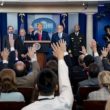Two numbers reveal everything you need to know about the U.S. economy over the past two decades. Between 1999 and 2018, the S&P 500 grew 6 percent annually, after accounting for dividends (2 percent annual gain) and inflation (2 percent annual loss). Stock prices more than doubled in value over this time period. Wall Street boomed.
Over the same time period, Main Street saw 0 percent gains. Workers got shut out. According to official government statistics, median household income rose a tiny fraction of one percentage point annually, after adjusting for inflation, and less than 3 percent in total. But this overstates how poorly average Americans have fared. A 2013 change in how the government collected its data led to a 3 percent increase in reported income. That means middle-class incomes actually changed little over two decades—even as more household members were working and people were working more jobs and more hours.
These two numbers (6 percent annual growth in the S&P and 0 percent net growth in median household income) are connected. Average incomes stagnated because corporations absconded with all economic gains; their profits then increased stock prices. The two numbers also delivered a dire political outcome. A third-rate real estate developer with a history of racism and misogyny became president because Americans sought change and thought Trump understood this, that he would help Main Street.
People voted for Donald Trump feeling they had nothing to lose after decades of income stagnation.
But lose we did. America lost respect around the world. Many lives have been lost to Covid-19 due to a deadly combination of incompetence and self-serving behavior. And even before the coronavirus hit, income gains during the Trump administration headed toward Wall Street; U.S. workers saw few benefits. Significantly, the president’s two signature economic policies, protectionism and tax reform, abetted this demoralizing outcome.
Donald Trump frequently complains about the U.S. trade deficit—the United States buys more from other nations than they buy from us. For him, this means U.S. jobs get sent abroad, hurting the U.S. economy. We are losers.
But the president gets things backward. U.S. trade deficits stem from an economy that is doing relatively better than its main trading partners. Low U.S. unemployment leads to more consumer spending and increased imports. High unemployment abroad leads foreign consumers to spend less. As they buy fewer U.S.-made goods, we export less.
China is an exception here and accounts for a majority of the U.S. trade deficit. This is because China doesn’t play by the rules. It steals intellectual property and protects Chinese firms from foreign competition. Cheap labor, and less spending on worker protection, lets China provide inexpensive parts to multinational firms. This puts downward pressure on U.S. wages as workers are threatened with having their jobs move to China.
President Obama developed the Trans-Pacific Partnership (which, in fairness, received uneven support here at home and a general thumbs-down from labor) to pressure China to end its trade restrictions and recognize intellectual property, using the combined force of China’s main trading partners as a cudgel. President Trump withdrew the United States from the Trans-Pacific Partnership upon taking office. China persevered with its trade policies. President Trump failed to change anything. The U.S. trade deficit with China in goods barely changed: from $347 billion in 2016 (pre-Trump) it fell to $346 billion in 2019.
Then there was Nafta—according to Trump, the worst trade deal ever and the cause of the U.S. trade deficit with Canada and Mexico. On July 1, Trump’s deal, the U.S.-Mexico-Canada Agreement, replaced Nafta. Yet this new North American trade deal differs little from Nafta. To the extent it does, it provides greater incentives for U.S. manufacturers to shed American jobs and move them to Mexico (see my article in the December 2018 Washington Spectator). So much for helping Main Street.
Trump has done even worse when it comes to taxation. He ran for president promising “the largest tax reductions . . . for the middle class” and a 35 percent tax cut for a middle-class family with two children. Actually, his 2017 tax bill did little for average Americans. Small tax breaks for some middle-income households will disappear over the next few years. Yet large corporations and the rich received huge tax cuts (see my article in the February 2018 Washington Spectator). After-tax corporate profits reached record levels.
As the tax bill made its way through Congress in 2017, the president claimed that his tax giveaway to corporations and the wealthy would trickle down. Everyone would gain. Firms would invest in efficient equipment and in their workers. Household income would rise $4,000 to $9,000. None of this happened. The standard trickle-down Republican hokum, peddled since the 1980s, had the same effect as in the past—the rich gained bigly.
Businesses’ investment grew more slowly in 2018 and 2019 than in 2016 and 2017. This is not surprising, as the new tax law provides huge incentives for companies to invest overseas rather than in the United States. Foreign subsidiaries of U.S. companies are now taxed at half the 21 percent corporate rate that applies to domestic profits.
Firms didn’t spend more money training their workers. Instead, record corporate profits were used to buy back outstanding shares of stock, with the goal of raising stock prices. Median household income rose $553 the year that Trump’s tax cut took effect—far from what was promised, and below the $847 increase in 2017 and the $978 gain in pre-Trump 2016.
President Trump was also wrong when he claimed his tax bill would be revenue neutral because the enormous economic growth it unleashed (5 percent or more) would generate enough tax revenue to pay for it. The economy grew at a rate of 2.5 percent in 2018 and 2019, a bit more than the 2 percent growth the two years prior to the tax cut, but half the promised 5 percent minimum. The result was a government budget $200 billion deeper in red ink each year.
Budget deficits are desirable sometimes. If consumers and companies can’t or won’t spend, the government must step in; otherwise, goods won’t be sold and workers will get laid off. At other times budget deficits are harmful. The 2017 tax cut was a huge mistake because it didn’t boost the economy and because workers on Main Street got nothing. It was an even bigger mistake because budget surpluses (or small deficits) during good economic times make it is easier to run large deficits in difficult times. The lost revenues could have supported the millions of Americans forced to stay at home in order to reduce coronavirus infections and save lives.
Covid-19 has led to massive job and income losses and rising household indebtedness. Wall Street panicked. From mid-February to mid-March, stock prices tumbled, reversing their entire gain during the Trump administration.
President Trump panicked in turn. Rather than addressing the pandemic, he pushed to reopen the economy, caring more about falling stock prices and how they might impact his election prospects than about American lives. Instead of listening to public health experts, he politicized the coronavirus. Initially he denied the problem, claiming it would disappear by April. He promoted phony cures that “someone” told him would work. He proudly pranced about without a face mask and held rallies without social distancing, scorning the two best ways to stop the coronavirus from spreading.
The latter action put Trump’s own supporters at risk. If they caught Covid-19 at a Trump rally, they would lose weeks of work while in quarantine, even if they had no symptoms, and months of work if they did. Covid-19 would spread to friends and family, putting lives at risk.
We can estimate the lives lost from not taking simple precautions and from reopening the U.S. economy too soon. Had the U.S. and Canadian Covid-19 death rate been the same, 96,000 fewer Americans would have died from Covid-19 (as of August 22). This is more than half of all U.S. Covid-19 deaths. If trends continue, by November more than 130,000 Americans will have died because the United States has not done as well as Canada. The rich can escape to their country estates, working safely from home and/or living off their wealth. Those getting ill and dying reside on Main Street.
Steven Pressman is professor of economics at Colorado State University, author of Fifty Major Economists, 3rd edition (Routledge, 2013), and president of the Association for Social Economics.







Thanks a bunch for sharing this with all folks you actually recognise what you are talking approximately!
Bookmarked. Please additionally visit my website =).
We could have a hyperlink trade arrangement among us
I was unable to print off the last issue of the Washington Spectator. I am unable to read long articles on my computer and need a printed copy. Since you are no longer sending a printed copy and if I cannot print off a copy on my computer, maybe I should just cancel my subscription. PLEASE tell me how I can print off the last newsletter and subsequent newsletters because I really enjoy reading the Spectator.
Hi Edith, thanks for your inquiry. You can download and print the issue by clicking the download button (looks like an arrow pointing downwards on a piece of paper) in the toolbar at this link: https://washingtonspectator.org/latest-issue/.
If you have any difficulty, please email us at [email protected] and I will send you individual printable copies.
Thank you,
Sophia Fish, Digital Editor